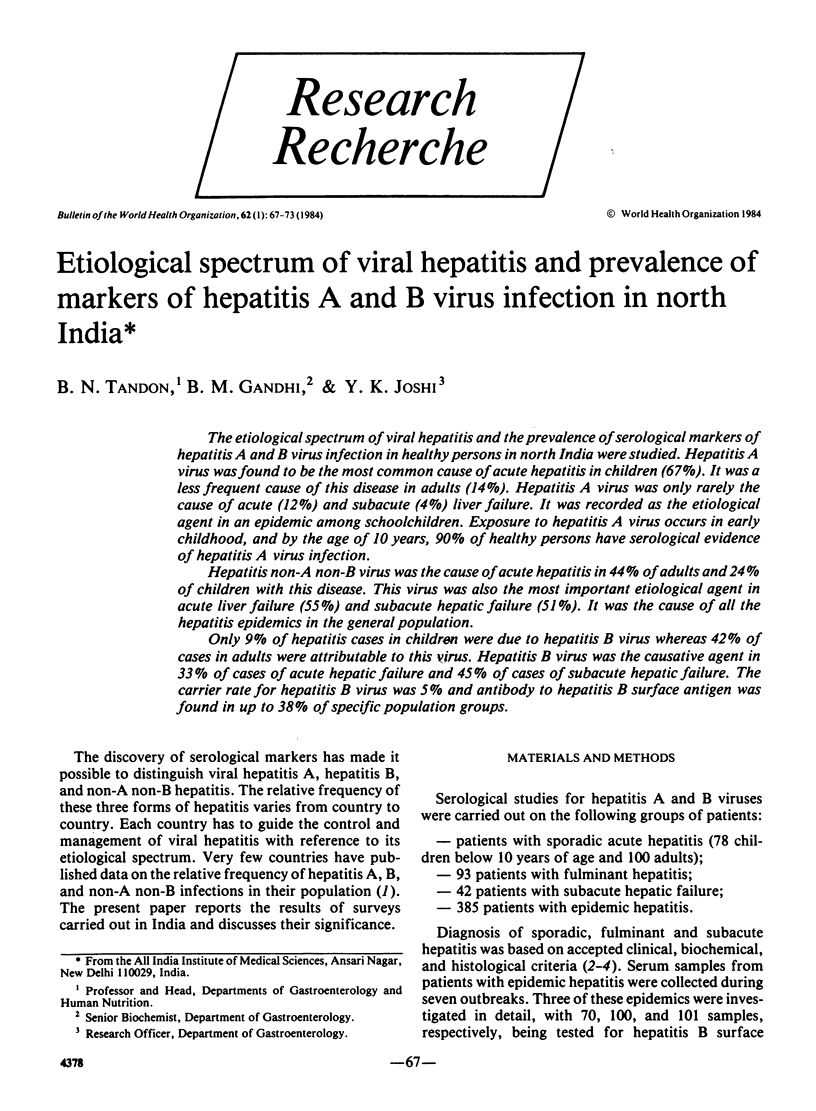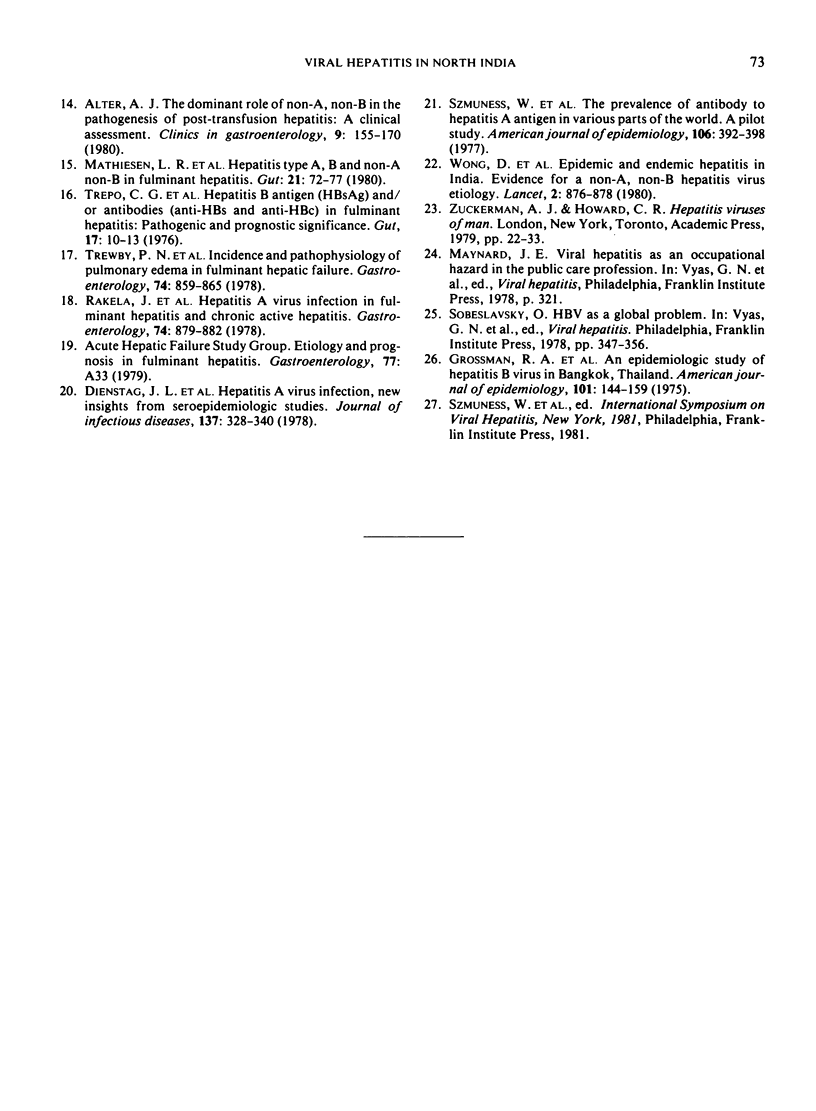Abstract
The etiological spectrum of viral hepatitis and the prevalence of serological markers of hepatitis A and B virus infection in healthy persons in north India were studied. Hepatitis A virus was found to be the most common cause of acute hepatitis in children (67%). It was a less frequent cause of this disease in adults (14%). Hepatitis A virus was only rarely the cause of acute (12%) and subacute (4%) liver failure. It was recorded as the etiological agent in an epidemic among schoolchildren. Exposure to hepatitis A virus occurs in early childhood, and by the age of 10 years, 90% of healthy persons have serological evidence of hepatitis A virus infection.
Hepatitis non-A non-B virus was the cause of acute hepatitis in 44% of adults and 24% of children with this disease. This virus was also the most important etiological agent in acute liver failure (55%) and subacute hepatic failure (51%). It was the cause of all the hepatitis epidemics in the general population.
Only 9% of hepatitis cases in children were due to hepatitis B virus whereas 42% of cases in adults were attributable to this virus. Hepatitis B virus was the causative agent in 33% of cases of acute hepatic failure and 45% of cases of subacute hepatic failure. The carrier rate for hepatitis B virus was 5% and antibody to hepatitis B surface antigen was found in up to 38% of specific population groups.
Full text
PDF






Selected References
These references are in PubMed. This may not be the complete list of references from this article.
- Alter H. J. The dominant role of non-A, non-B in the pathogenesis of post-transfusion hepatitis: a clinical assessment. Clin Gastroenterol. 1980 Jan;9(1):155–170. [PubMed] [Google Scholar]
- Caredda F., D'Arminio Monforte A., Lopez S., Culrado D., Moroni M. Epidemiology of non-A, non-B hepatitis. Lancet. 1979 Dec 22;2(8156-8157):1380–1380. doi: 10.1016/s0140-6736(79)92874-5. [DOI] [PubMed] [Google Scholar]
- Dienstag J. L., Szmuness W., Stevens C. E., Purcell R. H. Hepatitis A virus infection: new insights from seroepidemiologic studies. J Infect Dis. 1978 Mar;137(3):328–340. doi: 10.1093/infdis/137.3.328. [DOI] [PubMed] [Google Scholar]
- Mathiesen L. R., Skinhøj P., Hardt F., Nielsen J. O., Sloth K., Zoffmann H., Møller A. M., Wong D., Purcell R. H. Epidemiology and clinical characteristics of acute hepatitis types A, B, and non-A non-B. Scand J Gastroenterol. 1979;14(7):849–856. doi: 10.3109/00365527909181415. [DOI] [PubMed] [Google Scholar]
- Mathiesen L. R., Skinoj P., Nielsen J. O., Purcell R. H., Wong D., Ranek L. Hepatitis type A, B, and non-A non-B in fulminant hepatitis. Gut. 1980 Jan;21(1):72–77. doi: 10.1136/gut.21.1.72. [DOI] [PMC free article] [PubMed] [Google Scholar]
- Mathiesen L. R. The hepatitis A virus infection. Liver. 1981 Jun;1(2):81–109. doi: 10.1111/j.1600-0676.1981.tb00027.x. [DOI] [PubMed] [Google Scholar]
- Møller A. M., Mathiesen L. R. Detection of immunoglobulin M antibodies to hepatitis A virus by enzyme-linked immunosorbent assay. J Clin Microbiol. 1979 Nov;10(5):628–632. doi: 10.1128/jcm.10.5.628-632.1979. [DOI] [PMC free article] [PubMed] [Google Scholar]
- Rakela J., Redeker A. G. Chronic liver disease after acute non-A, non-B viral hepatitis. Gastroenterology. 1979 Dec;77(6):1200–1202. [PubMed] [Google Scholar]
- Rakela J., Redeker A. G., Edwards V. M., Decker R., Overby L. R., Mosley J. W. Hepatits A virus infection in fulminant hepatitis and chronic active hepatitis. Gastroenterology. 1978 May;74(5 Pt 1):879–882. [PubMed] [Google Scholar]
- Szmuness W., Dienstag J. L., Purcell R. H., Stevens C. E., Wong D. C., Ikram H., Bar-Shany S., Beasley R. P., Desmyter J., Gaon J. A. The prevalence of antibody to hepatitis A antigen in various parts of the world: a pilot study. Am J Epidemiol. 1977 Nov;106(5):392–398. doi: 10.1093/oxfordjournals.aje.a112481. [DOI] [PubMed] [Google Scholar]
- Trepo C. G., Robert D., Motin J., Trepo D., Sepetjian M., Prince A. M. Hepatitis B antigen (HBSAg) and/or antibodies (anti-HBS and anti-HBC) in fulminant hepatitis: pathogenic and prognostic significance. Gut. 1976 Jan;17(1):10–13. doi: 10.1136/gut.17.1.10. [DOI] [PMC free article] [PubMed] [Google Scholar]
- Trewby P. N., Warren R., Contini S., Crosbie W. A., Wilkinson S. P., Laws J. W., Williams R. Incidence and pathophysiology of pulmonary edema in fulminant hepatic failure. Gastroenterology. 1978 May;74(5 Pt 1):859–865. [PubMed] [Google Scholar]
- Trey C., Davidson C. S. The management of fulminant hepatic failure. Prog Liver Dis. 1970;3:282–298. [PubMed] [Google Scholar]
- Wong D. C., Purcell R. H., Sreenivasan M. A., Prasad S. R., Pavri K. M. Epidemic and endemic hepatitis in India: evidence for a non-A, non-B hepatitis virus aetiology. Lancet. 1980 Oct 25;2(8200):876–879. doi: 10.1016/s0140-6736(80)92045-0. [DOI] [PubMed] [Google Scholar]


